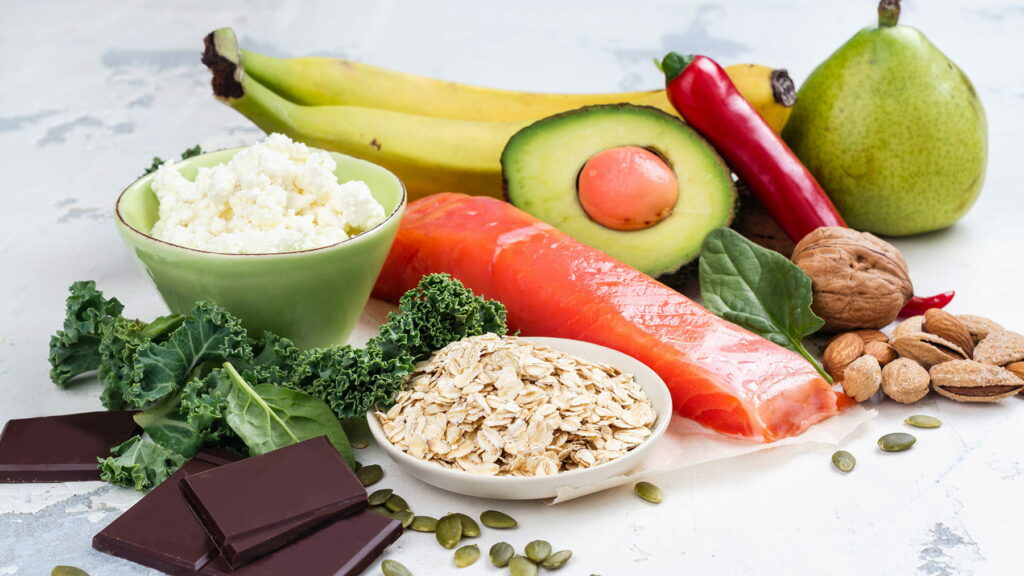A diet for cholesterol and diabetes can help manage both conditions effectively. Adopting a balanced and nutritious eating plan is essential for maintaining healthy cholesterol levels and blood sugar control.
This article will discuss the impact of diet on cholesterol and diabetes and provide practical tips and guidelines for creating a personalized meal plan. High cholesterol and diabetes often coexist due to shared risk factors and underlying metabolic abnormalities. Both conditions require dietary modifications that focus on reducing saturated and trans fats, limiting added sugars and refined carbohydrates, and incorporating more fiber-rich foods.
This can be achieved by emphasizing whole grains, lean proteins, fruits, vegetables, and healthy fats in the diet. Additionally, portion control, regular monitoring of blood sugar levels, and staying active are crucial for overall health and well-being. Read on to discover the specific dietary recommendations and strategies to effectively manage cholesterol and diabetes through healthy eating habits.
Table of Contents
Understanding Cholesterol And Diabetes
Cholesterol and diabetes are two common health conditions that can significantly affect the body. Cholesterol is a waxy substance found in the blood, which is essential for building healthy cells. However, high levels of cholesterol can lead to a buildup of plaque in the arteries, increasing the risk of heart disease and stroke. On the other hand, diabetes is a chronic condition in which the body is unable to properly regulate blood sugar levels. Both conditions are closely linked, as individuals with diabetes are more likely to have high cholesterol levels.
It is crucial to manage both diabetes and high cholesterol with a healthy diet. A balanced diet rich in fruits, vegetables, lean proteins, and whole grains can help regulate blood sugar levels and lower cholesterol levels. For individuals with diabetes, it’s important to focus on foods with a low glycemic index to prevent spikes in blood sugar. Additionally, incorporating healthy fats such as avocado, olive oil, and nuts can help improve cholesterol levels.
| Food to Include | Food to Limit |
|---|---|
|
|
By adopting a healthy eating pattern and making wise food choices, individuals can effectively manage both cholesterol and diabetes, reducing the risk of complications and improving overall health.
Building Your Balanced Diet
A balanced diet plays a crucial role in managing both cholesterol and diabetes. Macronutrients like carbohydrates, proteins, and fats are key components of a healthy diet. Focus on consuming whole grains, fruits, and vegetables to get sufficient carbohydrates. Good protein sources include lean meats, fish, tofu, and legumes. Incorporate healthy fats like avocados, nuts, and olive oil into your meals.
Fiber-rich foods are particularly beneficial in controlling blood sugar levels and lowering cholesterol. Include plenty of fruits, vegetables, whole grains, and legumes in your diet to get an adequate amount of fiber. It not only helps in reducing cholesterol levels but also slows down the absorption of glucose, preventing spikes in blood sugar.
Smart hydration choices are also essential for overall health maintenance. Opt for water, unsweetened beverages, and herbal teas instead of sugary drinks. Staying hydrated aids in digestion, circulation, and maintaining optimal body functions, which are crucial for managing cholesterol and diabetes effectively.
Essential Foods For Cholesterol And Diabetes
Fruits and vegetables play a vital role in maintaining optimum health for individuals with cholesterol and diabetes. These fiber-rich options include berries, cherries, leafy greens, and cruciferous vegetables like broccoli and cauliflower. Incorporating these colorful options into your meals can help improve cholesterol levels and regulate blood sugar.
Whole grains are another important food group to consider. Consuming options like oats, brown rice, and quinoa provides essential nutrients and helps stabilize blood sugar levels. Rich in fiber and low in glycemic index, they are excellent choices for individuals managing diabetes.
Lean proteins are essential for supporting overall health goals. Options such as skinless poultry, fish, and legumes are excellent sources of low saturated fat protein. These provide necessary nutrients without influencing cholesterol levels. Additionally, they assist in maintaining a healthy weight, which positively impacts both cholesterol and diabetes management.
| Fruits and Vegetables | Whole Grains | Lean Proteins |
|---|---|---|
| Berries | Oats | Skinless Poultry |
| Cherries | Brown Rice | Fish |
| Leafy Greens | Quinoa | Legumes |
| Cruciferous Vegetables |
Superfoods For Heart Health And Sugar Control
When it comes to managing cholesterol and diabetes, incorporating the right foods into your diet is essential. Nuts and seeds are loaded with healthy fats that can help lower bad cholesterol levels and improve blood sugar control. Adding a handful of almonds, walnuts, or chia seeds to your meals or snacks can provide a satisfying crunch while supporting heart health.
Legumes are versatile nutrient powerhouses that can be included in a variety of dishes. They are rich in fiber, protein, and minerals such as potassium and magnesium. Consuming legumes regularly can help reduce cholesterol and stabilize blood sugar levels. Incorporate lentils, chickpeas, or black beans into soups, salads, or main dishes for a nutritious boost.
Oily fish, such as salmon, mackerel, and sardines, are excellent sources of omega-3 fatty acids. These healthy fats are known for their heart-protective benefits and can help lower cholesterol and reduce inflammation. Aim to include oily fish in your diet at least twice a week to reap the omega-3 advantages.
| Fish Type | Frequency |
|---|---|
| Salmon | 2-3 servings per week |
| Mackerel | 2 servings per week |
| Sardines | 2 servings per week |
Incorporating Power Foods Into Everyday Meals
Eating a balanced diet is essential for managing both cholesterol and diabetes. By incorporating power foods into your everyday meals, you can support your overall health and well-being. Here are some ideas for breakfast, lunch, dinner, and snacks to help you get started:
Breakfast Ideas To Start The Day Right
- Include high-fiber foods such as whole grains, fruits, and vegetables in your breakfast.
- Choose lean sources of protein like eggs, Greek yogurt, or tofu.
- Opt for healthy fats from sources like avocado, nuts, or seeds.
- Consider adding spices like cinnamon or turmeric, known for their potential benefits in managing blood sugar levels.
Lunch Options For Sustained Energy
- Opt for lean proteins such as grilled chicken or fish.
- Incorporate whole grains like quinoa or brown rice for added fiber.
- Include a variety of colorful vegetables and leafy greens.
- Use heart-healthy oils like olive oil for dressings or cooking.
Dinner Dishes For A Satisfying End Of The Day
| Protein | Grains | Vegetables | Healthy Fats |
|---|---|---|---|
| Salmon | Quinoa | Broccoli | Avocado |
| Tofu | Whole wheat pasta | Spinach | Olive oil |
Snack Swaps To Curb Cravings
- Instead of processed chips, choose air-popped popcorn or roasted chickpeas.
- Enjoy a handful of nuts or seeds for a satisfying crunch.
- Opt for fresh fruits or vegetables with hummus or Greek yogurt dip.
- Stay hydrated with herbal teas or infused water.
By making mindful choices and including these power foods in your daily meals, you can support your body in maintaining healthy cholesterol and blood sugar levels. Remember to consult with a healthcare professional for personalized dietary recommendations.
Cooking Techniques That Preserve Nutrients
Diet plays a crucial role in managing both cholesterol and diabetes. When it comes to cooking techniques, there are several options that can help preserve the nutrients in your meals. Choosing healthy cooking methods is important for maintaining the nutritional value of your food.
One such technique is seasoning without excess sodium or sugar. Using herbs, spices, and other flavorful ingredients can add taste to your dishes without relying on unhealthy additives. This not only enhances the flavor of your meals but also reduces your intake of sodium and sugar.
Another important aspect is portion control for weight management. Monitoring the quantity of food you consume can help you maintain a healthy weight, which in turn can improve your cholesterol and diabetes levels. Opting for smaller portions and being mindful of portion sizes can make a significant difference in your overall health.
By adopting these healthy cooking methods, you can enjoy nutritious meals that are beneficial for both your cholesterol and diabetes management.
Reading Food Labels Wisely
Reading food labels is essential for managing a diet focused on cholesterol and diabetes. By understanding the information presented, you can make informed choices and maintain a healthy lifestyle.
Identifying Hidden Sugars And Harmful Fats
Sugar and unhealthy fats can be quite sneaky, hiding in various forms in processed foods. When reading food labels, keep an eye out for names such as corn syrup, fructose, dextrose, maltose, and sucrose, which are all types of added sugars. It’s important to identify these hidden sugars as they can significantly affect blood sugar levels and increase the risk of diabetes complications.
Additionally, watch out for trans fats and saturated fats listed in the ingredient list. These fats can raise LDL (bad) cholesterol levels and increase the risk of cardiovascular diseases. Look for phrases like “partially hydrogenated oils” or “high in saturated fat” on the label and avoid consuming foods that contain these harmful fats.
Spotting Whole Grain And High Fiber Options
Choosing whole grain and high fiber options can help manage cholesterol and blood sugar levels. When analyzing food labels, look for key phrases such as “100% whole grain” or “whole wheat” to ensure you’re getting the maximum nutritional benefit. Opting for whole grains can provide valuable dietary fiber which aids in digestion, helps maintain healthy cholesterol levels, and keeps blood sugar stable.
Understanding Portion Sizes And Serving Recommendations
Portion sizes can greatly impact your calorie intake and blood sugar levels. Pay close attention to the serving size listed on the food label, as it may differ from what you typically consume. Be mindful of portion sizes and try to measure your food to avoid overeating.
Additionally, the label’s serving recommendations offer insights into how the product fits into a balanced diet. Following the suggested serving sizes can help control calorie intake and ensure you are consuming essential nutrients in appropriate amounts.
Staying Active: Complement Your Dietary Efforts
Regular physical activity is essential for maintaining a healthy lifestyle, especially for individuals with high cholesterol and diabetes. Engaging in exercise can help lower cholesterol levels, improve blood sugar control, and reduce the risk of heart disease.
Exercise types beneficial for diabetes and heart health
When it comes to choosing the right type of exercise, both aerobic exercises and strength training are beneficial. Aerobic exercises such as walking, jogging, swimming, or cycling can help improve cardiovascular health and manage diabetes. Strength training exercises, on the other hand, help build lean muscle mass, which aids in improving insulin sensitivity and controlling blood sugar levels.
Moreover, finding a routine that fits your lifestyle is crucial. Whether it’s going for a brisk walk during your lunch break, joining a fitness class, or working out at home, the key is to be consistent and make physical activity a part of your daily routine.
Monitoring Your Progress
Maintaining a healthy diet is crucial for managing both cholesterol and diabetes. One important aspect of monitoring your progress is tracking the dietary changes you make and their effects on your body. Regular checkups to measure cholesterol and glucose levels are essential to determine how your diet is impacting your overall health. By keeping an eye on these levels, you can make any necessary adjustments to your diet to achieve the optimal results. This might involve reducing saturated and trans fats, increasing fiber intake, limiting processed foods, and incorporating more fruits, vegetables, whole grains, and lean proteins. Remember to consult with your healthcare provider or a registered dietitian for personalized guidance suited to your specific condition and needs.

Credit: www.health.harvard.edu
Sticking To Your Diet Amid Challenges
Maintaining a healthy diet can be challenging, especially when faced with holidays and gatherings. However, with the right strategies, it is possible to stick to your diet and manage cholesterol and diabetes effectively.
Strategies For Maintaining Diet During Holidays And Gatherings
When dining out, it’s important to make informed choices. Opt for lean proteins like grilled fish or chicken and choose steamed or roasted vegetables as side dishes. Avoid fried and breaded items, and ask for dressings and sauces on the side to control portion size and minimize added fats and sugars. Select whole grain options when available.
To overcome common obstacles to diet adherence, planning ahead is key. Bring a healthy dish to share at gatherings to ensure there are suitable options available. Eat a small, balanced meal or snack before attending an event to avoid overindulging on unhealthy choices. Stay hydrated and keep healthy snacks on hand to avoid hunger-induced poor food choices.
By implementing these strategies, you can navigate holiday and gathering settings while staying true to your cholesterol and diabetes diet.
Frequently Asked Questions For Diet For Cholesterol And Diabetes
What Is The Best Diet For Managing Cholesterol And Diabetes?
A healthy diet rich in fruits, vegetables, whole grains, and lean proteins is the best choice for managing cholesterol and diabetes. Avoiding processed foods high in saturated fats and added sugars is crucial. Focus on portion control and include foods that can help lower cholesterol and stabilize blood sugar levels.
Can Certain Foods Help Lower Cholesterol And Control Diabetes?
Absolutely! Foods like nuts, avocados, fatty fish, and oats can help lower cholesterol levels. Additionally, incorporating foods such as leafy greens, berries, beans, and whole grains into your diet can help control blood sugar levels in individuals with diabetes.
Is It Possible To Follow A Low Cholesterol And Low Glycemic Index Diet Together?
Yes, it is possible to combine a low cholesterol and low glycemic index diet. By choosing foods that are low in saturated fats and have a low glycemic index, you can effectively manage both conditions. It’s important to consult with a healthcare professional or a registered dietitian to create a personalized plan.
Are There Any Specific Foods Or Nutrients That Should Be Avoided?
To manage cholesterol and diabetes, it’s important to limit the intake of foods high in saturated fats, trans fats, refined sugars, and processed carbohydrates. Additionally, individuals should be cautious about high levels of sodium and alcohol consumption as they can contribute to high cholesterol and uncontrolled blood sugar levels.
Conclusion
To sum up, adopting a healthy diet is crucial for managing cholesterol and diabetes. By focusing on whole foods, such as fruits, vegetables, lean proteins, and whole grains, you can effectively lower cholesterol levels and regulate blood sugar levels. Remember to limit intake of saturated and trans fats, as well as processed and sugary foods.
Incorporating regular physical activity and staying hydrated are also important factors in maintaining overall health. By making these changes, you can significantly improve your well-being and reduce the risk of complications associated with cholesterol and diabetes.
- Best Information about Car Mechinery








